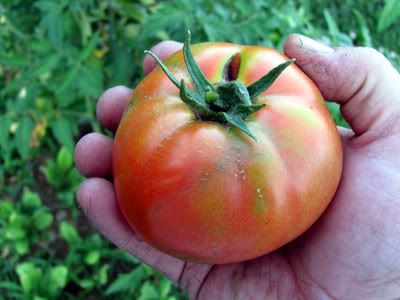Benefit with vermicompost from your own wormery!
As you may or may not know, I have a worm bin full of thousands of redworms that I keep in our dining room. The whole family enjoys feeding the worms our vegetable scraps and watching the babies hatch. My worm bin is the Gardens Alive Worm Factory.
I have written before about setting up the worm bin here and here. I have written about how to harvest the worm compost from the bin, but I have never really shown why vermicompost is so great.
Worm castings, or vermi-compost is the super compost - the best organic natural fertilizer possible for your plants. I have always read this and believed it, but this year I decided to put it to the test.
Remember the Pea bed that I prepared back in March? In that bed, I put two rows of chicken wire fence with two rows of peas on either side of each fence. Afther the peas got growing, they looked like this:

For my experiment I put freshly harvested worm compost as a top dressing on the two rows of peas on one fence and not on the other.

After a few weeks, the pea vines on the composted side grew so much bigger than the other side that they reached above the fence and fell over! They also yielded many more peas! The easiest way to show you the difference is by this split screen picture:

The left side had the vermicompost added. Look how much thicker the vine is than the one on the right. The right side did well too. I never would have known the power of the worms if I hadn't done this side-by-side test. The peas were fabulous, by the way.

On the same day I added the worm castings to the peas, I transplanted my last early tomato plant. I added a generous amount of the worm compost to it's hole as well.


It may be just a coincidence, but that is the plant that has been giving us our early ripe tomatoes so far! The other early tomato plants haven't ripened yet. Sounds fishy doesn't it? Or should I say wormy! I'm convinced that the vermi-compost made the difference. It makes me want to get another tray started on my Worm factory right away. Each finished tray makes quite a bit of compost.

I have a friend that has been asking me about worm composting and how to do it. That has made me realize that I never really written a comprehensive how-to compost with worms post. I am now in the process of doing that. It will be added to gardendesk.com as a page. Worm composting is one of many topics that I write about but don't really give good details to the beginner. I apologize for that and am working on making that better. That is why I started the GardenDesk page arm of this site. So far I do have a general composting page, a seed-starting page and a beneficial insect page. Soon I will add a worm composting page and several others.
For now all I can do for my friend is refer her to my worm composting thread and recommend some books like Worms Eat My Garbage: How to Set Up and Maintain a Worm Composting System and The Worm Book . Also, my Worm Factory came with a great little informational booklet that I am loaning to her. She has said that she may buy the same bin that I have which made me remember the Gardens Alive online $20 off coupon that they have. You can get that by clicking here:
I posted that primarily for her, but anyone can use it. It leads to the main Gardens Alive page and is good for any of their products. If you are looking for the Worm Factory, you then need to search for "Worm Composting System". I highly recommend worm composting and endorse the Gardens Alive Worm Factory.
Other than my friend reading this, I'd love to here others thoughts on worm bin composting. Do you have one? Have you made one yourself that you are happy with? Does the idea intrigue you or disgust you. One thing is sure, vermicompost IS nature's super-compost!
Keep Growing!
- Marc


















